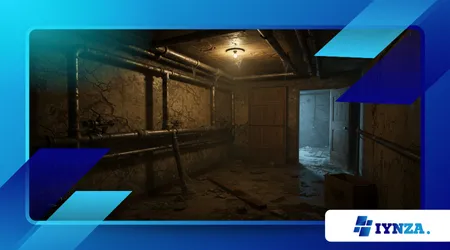What Makes Indie Horror Games Scarier Than AAA Titles?

The Indie Horror Games that keep players up at night don’t have the biggest budgets, the flashiest graphics, or celebrity voice actors. But they do something many AAA horror titles struggle to replicate: they make fear feel personal.
Anúncios
In the absence of corporate safety nets and franchise expectations, indie developers are free to experiment. That freedom leads to unsettling atmospheres, unpredictable storytelling, and mechanics designed to discomfort—not entertain.
If you’ve ever felt more dread playing a pixelated game alone in your room than you did during a Hollywood-level blockbuster, you’re not imagining things. Indie horror is built different. And that difference is exactly what makes it work.
Minimalist Design Creates Maximum Psychological Effect
Without access to cinematic engines or lifelike animation, indie horror devs lean into atmosphere. They strip away the polish and leave behind raw tension. In many indie games, what you can’t see is far more terrifying than what you do.
The sound of distant footsteps. A flickering light. A single door that wasn’t open before. These are deliberate design choices. When developers remove visual excess, they force players to focus. That focus becomes a trap. You listen too hard. You look too long. Your own imagination becomes the enemy.
AAA games often overexpose the monster. Indie horror lets the unknown do the work.
Unconventional Stories Hit Harder Than Familiar Tropes
Indie horror isn’t afraid to go weird. These games don’t rely on haunted houses, possessed dolls, or zombie apocalypses. They explore grief, isolation, dissociation, and madness—not as set dressing, but as themes that infect the gameplay itself.
You’re not just scared because of what’s on screen. You’re scared because of what the game is suggesting. That maybe you’re the one being watched, maybe your decisions are being judged, maybe the glitch isn’t a bug—it’s a warning.
This narrative boldness creates psychological horror with staying power. You turn off the game, but it doesn’t turn off in you.
Read also: From Pixel to Prestige: How Indie Games Became Award-Winning Masterpieces
Player Powerlessness Is by Design, Not Accident
Big-budget horror often gives players tools—guns, companions, or safe rooms—to create pacing. Indie horror removes that safety net.
By denying players control, indie games simulate true fear. They recreate that childhood feeling of helplessness. And they never break the illusion. Even save points might not work the way you expect. Even quitting might feel wrong.
Some titles intentionally distort menus, load screens, or pause functions. Nothing is sacred. The fear lives in the code, and it doesn’t respect your boundaries.
One Developer, One Vision—No Compromise
Unlike AAA titles made by massive teams and approved by corporate layers, indie horror games often come from one person or a tiny studio. That intimacy shows.
You feel like you’re inside someone’s mind. Their anxieties, obsessions, and nightmares bleed into every mechanic. The game becomes a confession. And you’re the one listening.
This creative purity leads to experiences that feel honest—even when they’re disturbing. They weren’t made to sell millions. They were made to say something. To process something. To haunt someone.
That rawness makes the fear feel real.
Players Crave Authentic Fear, Not Predictable Scares
In a time where many horror games follow formulas, players are gravitating toward titles that surprise them. Indie horror breaks formulas.
And that’s why it sticks.
The fear you feel while playing comes from knowing that you don’t know what will happen next. There’s no guarantee the game will play fair. And that’s more terrifying than any jump scare.
The Rise of Analog Horror and Internet Folklore
Indie horror has birthed entire subgenres like analog horror—games inspired by VHS tapes, forgotten websites, and haunted software. These experiences tap into the uncanny familiarity of things that feel real but aren’t.
Games like these create immersive myths. They blur fiction and reality. And they spread not just through gameplay, but through communities—YouTube theories, Reddit threads, and player dissections.
This collective storytelling deepens the fear.
Why Streamers Love Indie Horror (And Why That Matters)
Content creators have fueled the popularity of indie horror because these games produce real reactions. They’re unpredictable. They’re intense. They catch even experienced players off guard.
When a streamer jumps out of their chair, viewers feel it too. Indie horror is performance fuel—and that fuels discovery. Small games go viral. New developers get visibility. And the cycle of innovation continues.
Even viewers who never pick up a controller still remember what scared them.
A Data Snapshot That Proves the Trend
According to a 2024 industry report by Newzoo, indie horror games saw a 37% increase in downloads across PC platforms compared to AAA horror titles, which declined 12% in the same period.
Players cited originality, tension, and “emotional impact” as the top reasons for choosing indie experiences over franchise entries.
Conclusion: Why Indie Horror Isn’t Going Anywhere
Indie Horror Games remind us that fear doesn’t need a budget. It needs honesty. It needs risk. And it needs a willingness to make players uncomfortable—not with gore, but with truth.
What makes these games unforgettable isn’t how they look. It’s how they make you feel. Alone. Uncertain. Unsettled.
And in a gaming world full of noise and spectacle, that quiet, personal kind of fear cuts deeper. It lingers long after the credits roll. Because deep down, we know the scariest things aren’t monsters—they’re reflections.
FAQ: Why Indie Horror Games Hit Harder
What makes indie horror scarier than mainstream titles?
Indie games rely on atmosphere, narrative risk, and personal storytelling rather than predictable mechanics or flashy visuals.
Are indie horror games harder than AAA ones?
Often, yes. They remove safety nets like weapons, maps, or hints to increase tension and player vulnerability.
Why do so many streamers play indie horror?
Because these games deliver real reactions. Their unpredictability creates compelling content that draws in viewers.
Can a game made by one person really be scary?
Absolutely. Many of the most unsettling games are passion projects built around raw emotional themes.
Is analog horror just a trend, or something deeper?
It’s deeper. Analog horror taps into nostalgia, unease, and the fear of the familiar turned strange. It’s storytelling evolution in real time.
